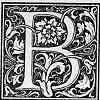 HOME
HOMEEncyclopedia Home Page
B
BAAL - BARN
BARR - BELC
BELE - BLUE
BIBLE
BOAR - BREA
BRET - BUIL
BUL - BY


The primitive designation of the month Marchesvan (see Zif). Doctor Oliver says in his Landmarks (11, 551), that this is one of the names of God among the ancients. It is also said to be an Assyrian word signifying Lord or Powerful.
BULL, OLE BORNEMANNFamous Norwegian violinist. Born at Bergen, February 5, 1810, and died near there on August 17, 1880. After brilliant concert tours in Europe, was in the United States, 1843-5, and again, 1852-7. James Herring, formerly Grand Secretary of the Grand Lodge of New York, gave an address at the celebration of the centennial anniversary of Saint John's Lodge No. 1, New York, December 7, 1857, showing that Ole Bull was a Freemason. He gave his farewell concert in New York, October 30, 1845, for Masonic charitable purposes, the Grand Lodge Widows' and Orphans' Fund, which netted the Craft $1,427.55. |
 |
An edict or proclamation issued from the Apostolic Chancery, with the seal and signature of the Pope, written in Gothic letters and upon coarse parchment. This derives its name from the leaden seal which is attached to it by a cord of hemp or silk, and which in medieval Latin is called bulla. Several of these Bulls have from time to time been aimed against Freemasonry and other secret societies, subjecting them to the heaviest ecclesiastical punishments, even to the greater excommunication. According to these Bulls, a Freemason is by reason of that fact excommunicated by continuing his membership in the Society, and is thus deprived of all spiritual privileges while living, and the rites of burial when dead.
|
|
|
Whatever may have been the severity of the Bulls issued by the predecessors of Leo XIII, he with great clearness ratifies and confirms them all in the following language: | |
This letter of the Roman hierarchy thus commences:
|
|
One is the kingdom of God on earth .., the other is the kingdom of Satan".
"That, by accepting any that present themselves, no matter of what religion, they (the Freemasons) gain their purpose of urging that great error of the present day, viz., that questions of religion ought to be left undetermined, and that there should be no distinction made between varieties. And this policy aims at the destruction of all religions, especially at that of the Catholic religion, which, since it is the only true one, cannot be reduced to equality with the rest without the greatest injury".
"But, in truth, the sect grants great license to its initiates, allowing them to defend either position, that there is a God, or that there is no God".
Thus might we quote continuous passages, which need only to be stated to proclaim their falsity, and yet there are those who hold to the doctrine of the infallibility of the Pope.
The name given by the Grand Orient of France to the monthly publication which contains the official record of its proceedings. A similar work has been issued by the Supreme Council of the Ancient and Accepted Rite for the Southern Jurisdiction of the United States of America, and by several other Supreme Councils and Grand Orients.
During the first two or three decades after the forming of the first Grand Lodge of Speculative Masons in London, in 1717, the daily papers of London, and to a lesser extent in Edinburgh, Dublin, and other cities, published news about Freemasonry on the same footing as other news. In its earliest years the new Grand Lodge published no Proceedings, and did not even keep Minutes; after the Lodges had multiplied not only in London, but elsewhere they began to demand reports from the Quarterly Grand Communications. The earliest Grand Lodge Minutes (reproduced in facsimile in Quatuor Coronati Antigrapha) were in reality not Minutes but reports, and in them the list of Lodges were deemed the most important portion. It was to save the Grand Secretary the drudgery of making many copies by hand that the "Minutes" were for some years engraved by Pine with his successors hence the origin of the famous "Engraved Lists" upon which Bro. John Lane was the first and most eminent authority. (See Lane's Lists of Lodges.)
The earliest Lodges demanded that their members should attend, and in many instances fined them for non-attendance; to make this rule "all-square" the Lodge in turn had its Tiler (who was paid) go in person to notify each member of the next Lodge meeting.
This method gradually gave way to the issuing of printed summons, for which an engraved plate was made, leaving a blank for the date; a number of these plates were masterpieces of the engraver's art - an art which had a large vogue in the Eighteenth Century.
The same methods were used in general by American Lodges until after the Revolution, when for about a quarter of a century they made a large use of newspapers. With the sudden explosion of the Anti-Masonic Crusade after the so-called "Morgan Affair" this publicity was stopped, and for many years was not encouraged even after the crusade had died away because it had been abused.
From the Civil War to the first decade of the Twentieth Century a Lodge either sent out no notices, or spread them by word of mouth, or published very brief and formal notices in papers.
In the beginning of this Century Lodges began the issuing of Bulletins, a method being used, or being adopted, by an ever-increasing number. In majority of instances a Bulletin is printed by the Lodge and prepared and mailed by the Secretary; in a minority of instances, especially in cities, either Bulletins or small periodicals are privately prepared and published by local printers who cover their costs and a very small margin of profits with an income from local advertising.
The typical Lodge Bulletin is a printed two or four pages leaflet, of envelope size; in it are names, addressed, and telephone numbers of Lodge officers, and oftentimes of Committee chairmen, or Committee members; notices of regular or special Communications, and of special occasions; and in some instances a small number of news items.
Lodge Bulletins have been discussed in Masonic jurisprudence; and both Grand Lodges and Grand Masters have made rules or decisions to regulate them.
It is generally accepted and established that a Lodge, or the Worshipful Master, or both, have the authority to exercise complete control of any information or news which emanates from or about a Lodge, whether published by the Lodge itself or by a private printer or publishing company.
BUNYAN, JOHNThe well-known author of the Pilgrim's Progress. He lived in the seventeenth century, and was the most celebrated allegorical writer of England. His work entitled Solomon's Temple Spiritualized will supply the student of Masonic symbolism with many valuable suggestions. |
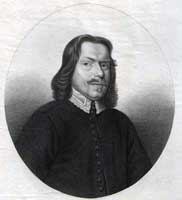 |
BURBANK, LUTHERFamous horticulturist, born March 7, 1849; died April 11, 1926. Became a Freemason in Santa Rosa Lodge No. 57, in California, on August 13, 1921. His successful experiments with fruits and flowers gave him an international reputation (see New Age, March, 1925). |
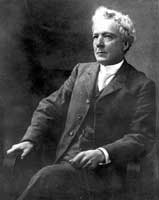 |
A class of workmen at the Temple mentioned in Second Chronicles (11. 18), and referred to by Doctor Anderson (Constitutions 1738, page i i), as the Ish Sabbal, which see.
See International Bureau for Masonic affairs
The first god of Norse mythology. In accordance with the quaint cosmogony of the ancient religion of Germany or that of Scandinavia, it was believed that before the world came into existence there was a great void, on the north side of which was a cold and dark region, and on the south side one warm and luminous. In Niflheim was a well, or the "seething caldron", out of which flowed twelve streams into the great void and formed a huge giant.
In Iceland the first great giant was called Ymir, by the Germans Tuisto (Tacitus, Germania, chapter 2), whose three grandchildren were regarded as the founders of three of the German races. Contemporary with Ymir, and from the great frost blocks of primeval chaos, was produced a man called Buri, who was wise, strong, and beautiful. His son married the daughter of another giant, and their issue were the three sons Odin, Wili, and We, who ruled as gods in heaven and earth. By some it has been earnestly believed that upon these myths and legends many symbols of Freemasonry were founded.
The right to be buried with the set ceremonies of the Order is one that, under certain restrictions, belongs to every Master Mason.
None of the ancient Constitutions contain any law upon this subject, nor can the exact time be now determined when funeral processions and a burial service were first admitted as regulations of the Order.
The first official notice, however, that we have of funeral processions is in November, 1754. A regulation was then adopted which prohibited any Freemason from attending a funeral or other procession clothed in any of the jewels or clothing of the Craft, except by dispensation of the Grand Master or his Deputy (see Constitutions, 1756, page 303).
There are no further regulations on this subject in any of the editions of the Book of Constitutions previous to the modern code which is now in force in the Grand Lodge of England. But Preston gives us the rules on this subject, which have now been adopted by general consent as the law of the Order, in the following words:
"No Mason can be interred with the formalities of the Order unless it be by his own special request communicated by the Master of the Lodge of which he died a member, foreigners and sojourners excepted; nor unless he has been advanced to the third degree of Masonry, from which restriction there can be no exception. Fellow Crafts or Apprentices are not entitled to the funeral obsequies" (see Illustrations, 1792, page 118).
The only restrictions prescribed by Preston are, it will be perceived, that the deceased must have been a Master Mason, that he had himself made the request and that he was affiliated, which is implied by the expression that he must have made the request for burial to the Master of the Lodge of which he was a member.
The regulation of 1754, which requires a Dispensation from the Grand Master for a funeral procession, is not considered of force in the United States of America, where, accordingly, Freemasons have generally been permitted to bury their dead without the necessity of such Dispensation.
Born January 12, 1729, new style, at Dublin, Ireland, and died July 8, 1797, in England. Famous statesman, writer and orator who championed the cause of the American Colonists on the floor of the English Parliament, April 19, 1774.
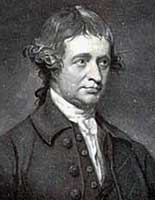 |
His father, a Protestant attorney, his mother a Roman Catholic Published in 1756 the satire A Vindication of Natural Society, then his Philosophical Inquiry into the Origin of our Ideas on the Sublime and Beautiful, translated into German and annotated by another Freemason, Lessing; a series of Hints on the Drama and an Abridgment of the History of England; and became interested in America and wrote an Account of the European Settlements. Brother George W. Baird (Builder, October, 1923) says that Burke was a member of Jerusalem Lodge No. 44, Clerkenwell, London. In Builder (July, 1923), Brother Arthur Heiron mentions Samuel Johnson, James Boswell, Sir William Forbes, Richard Savage, Alexander Pope, Richard Garriek, Jonathan Swift, close friends or contemporaries of Burke, as active and proven Freemasons. There is an impressive statue of Edmund Burke at Washington, District of Columbia (see also New Age, January, 1924). |
BURNES, SIR JAMESA distinguished Freemason, and formerly Provincial Grand Master of Western India under the Grand Lodge of Scotland from 1836 to 1846. In 1846 he was appointed Grand Master of Scottish Freemasons in India. He returned home in 1849, and died in 1862, after serving for thirty years in the Indian Medical Service. He was the author of an interesting work entitled a Sketch of the History of the Knights Templars. By James Burnes, LLD., F.R.S., Knight of the Royal Hanoverian Guelphic Order; published at London, in 1840, in 74 + 60 pages in small quarto. |
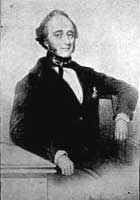 |
BURNING BUSHIn the third chapter of Exodus it is recorded that, when Moses was keeping the flock of Jethro on Mount Horeb, "the angel of the
Lord appeared unto him in a flame of fire out of the midst of a bush", and there communicated to him for the first time his ineffable
Name. This occurrence is commemorated in the Burning Bush of the Royal Arch Degree. In all the systems of antiquity, fire is adopted
as a symbol of Deity; and the Burning Bush, or the bush filled with fire which did not consume, whence came forth the Tetragrammaton,
the symbol of Divine Light and Truth, is considered in the advanced degrees of Freemasonry, like the Orient in the lower, as the
great source of true Masonic light; wherefore Supreme Councils of the Thirty-Third Degree date their balustres, or official
documents, "near the |
|
On page 164 of this Encyclopedia Bro. Dudley Wright is quoted in a passage which tries to show that the long tradition that Robert Burns had been named Poet-Laureate of Canongate Kilwinning Lodge was "a happy delusion"; and Bro. Robert I. Clegg, when quoting him, makes use of a pamphlet which that Lodge had published in 1925. It is possible that both of these cautious editors overlooked the detailed and exhaustive History of the Lodge Canongate Kilwinning No. 2, by Allan MacKenzie; Edinburgh; 1888 Bro. MacKenzie devotes the whole of one chapter to the Laureateship. Out of Lodge records, personal correspondence, the recollections of old members, newspapers, reports, and by use of internal evidence he constructs an argument solid enough and cogent enough to convince a Supreme Court.
Bro. Wright uses as an argument the fact that no record was made in the Lodge Minutes. It was never suggested that the naming of Burns as Poet Laureate had ever been made by the Lodge in an official action, and hence it naturally would not go into the Minutes; it is more likely that it was made at a banquet, informally, by the body of the members acting spontaneously. Even so, Burns accepted it in all seriousness; as did also the Lodge, which went to great expense to have the painting made which is reproduced on the sheet following page 156.
As will be seen in the image below that reproduction one of the notables whose portrait stands out conspicuously from a circle of notables is James Boswell, biographer of Dr. Samuel Johnson. Boswell was made a Mason in the Lodge in 1759; was Junior Warden in 1761; was Depute Master in 1767-1768; and Right Worshipful Master from 1773 to 1775.
Bro. MacKenzie's book is a wonderfully moving picture of Lodge life in Eighteenth Century Scotland.
Through it move James Hogg, the "Atrox Shepherd", successor to Bums as Scotland's poet, celebrated in a stanza by Wordsworth, who when asked to be Masonic Poet Laureate first refused, then relented and wrote a Masonic "shepherd's song" for his Lodge; Sir Wm. Forbes; the tremendous Lord Mondobbo; Henry Erskine; some princes from Russia, etc.; the Lockharts, father and son, the latter Sir Walter Scott's son-in-law and biographer; and Professor Wilson, better known as Christopher North, author of the Noctes A Ambrosianae, which American book lovers still read; and in the background, Sir Walter Scott and his father, both enthusiastic Craftsmen in their own Lodge.
|
One of the most celebrated and best loved of Scottish poets. William Pitt has said of his poetry, "that he could think of none since Shakespeare's that had so much the appearance of sweetly coming from nature". Robert Burns, or Robert Burness, as the name was originally spelled, was born at Kirk Alloway, near the town of Ayr, January 25, 1759. His father was a religious peasant-farmer living in a humble cottage on the banks of the Doon, the river destined to be eulogized so touchingly in many of Burns' verses in after life. Burns died in the thirty-seventh year of his life on July 21, 1796, broken in health. For years he had been feted, lionized and honored by the entire Scottish nation.
At the age of twenty-three he became closely associated with the local Freemasonry, being initiated July 4, 1781, in Saint David's Lodge, Tarbolton, shortly after the two Lodges of Saint David, No. 174, and Saint James, No. 178, in the town were united.
He took his Second and Third Degrees in the month of October following his initiation. In December Saint David's Lodge was divided and the old Lodge of Saint James was reconstituted, Burns becoming a member. Saint James' Lodge has still in its keeping, and we have personally inspected the Minute Books containing items written in Burns' own handwriting, which Lodge he served as Depute Master in 1784.
From this time on Freemasonry became to the poet a great and propelling power. At the time of his initiation into Saint David's Lodge Burns was unnoticed and unknown and, it must be admitted, somewhat unpolished in manner, although he had managed to secure before his sixteenth year what was then considered to be an "elegant" education.
With almost no exceptions his boon companions were all Freemasons and this close association with Brethren, many of whom were high in the social scale, but who recognized his talents and ability, did much to refine and stimulate him intellectually, influence his thought, inspire his muse, and develop that keen love of independence and brotherhood which later became the predominant factors of his life. The poet held the position of Depute Master of Saint James' Lodge until about 1788, at which time he read his famous Farewell to the Brethren of Saint James' Lodge, Tarbolton, given below:
|
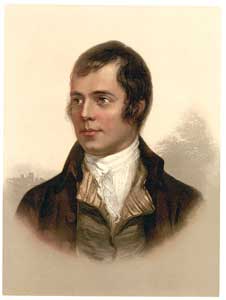 |
About this same time the poet presided as Master over a Lodge at Mauchline, which practice was, as a matter of fact, irregular, as the Charter of the Lodge covered only meetings held in Tarbolton, but, it is stated, Burns' zeal in the furthering of Freemasonry was so great that he even held Lodges in his own house for the purpose of admitting new members.
Mention is also made, however, that Lodges were not then tied to a single meeting place as now. Regarding this, Professor Dugald Stewart, the eminent philosophic writer and thinker, and himself an Honorary Member of the Saint James Lodge, says:
"In the course of the same season I was led by curiosity to attend for an hour or two a Masonic Lodge in Mauchline, where Bums presided.
He had occasion to make some short, unpremeditated compliments to different individuals from whom he had no reason to expect a visit, and everything he said was happily conceived and forcibly as well as fluently expressed".
Burns found himself in need of funds about this time and it was due to the suggestions and assistance of Gavin Hamilton, a prominent member of the Order and a keen admirer of Bums, that the poet collected his first edition of poems and was able to have them published through the able assistance of such eminent Fellow Craftsmen as Aiken, Goudie, John Ballantine, and Gavin Hamilton. A Burns Monument has since been erected, in August, 1879, in Kay Park, which overlooks the little printing office where the first Kilmarnoek edition of his poems was published.
Dr. John Mackenzie, a man of fine literary taste and of good social position, whom Bums mentions in several of his Masonic poems, lid much at this period by. way of kindly and discerning appreciation to develop the poet's genius and make it known to the world. It was due to a generous loan made by John Ballantine, before mentioned, that Burns was able to make the trip to Edinburgh and have a second edition of his poems published. At Edinburgh, due to the good offices of the Masonic Brethren there, Burns was made acquainted with and was joyously accepted by the literary leaders of the Scottish capital. Reverend Thomas Blacklock, a member of the Lodge of Saint David, Edinburgh, No. 36, and afterwards Worshipful Master of Ayr Kilwinning Lodge, received Burns on his arrival, lavished upon him all the kindness of a generous heart, introduced him into a circle of friends worthy and admiring, and did all possible to further the interest of the young poet. Brother Sir Walter Scott, the novelist, addressed a letter to this Lodge of Saint David, Edinburgh, which is now in their possession in which he pays rare tribute to Robert Burns.
On October 26, 1786, Burns was made an Honorary Member of the Saint John Lodge, No. 22, Kilmarnock, the first of the Masonic Orders to designate him as their Poet and honor him with honorary membership. Just previous to this he joined the Saint John's Kilwinning Lodge, Kilmarnock, warranted in 1747 but not coming under Grand Lodge until 1808, on which occasion in the Lodge was presided over by his friend, Gavin Hamilton. On February 1, 1787, Burns became a member of the Lodge of Canongate Kilwinning, No. 2, Edinburgh, which possesses the most ancient Lodge room in the world, and this Lodge is said to have invested Burns with the title of the Poet-Laureate of Lodge Canongate Kilwinning on March 1, 1787, from which time on Burns affixed the word Bard to his signature. This Lodge issued a booklet on Saint John's Day 1925, from which we quote the following:
"The fact of the inauguration of Burns as Poet-Laureate was, some time ago, finally and judicially established after an elaborate and exhaustive inquiry by the Grand Lodge of Scotland, which possesses the well-known historic Painting representing the scene, painted by Brother Stewart Watson, and presented to Grand Lodge by Dr. James Burness, the distinguished Indian traveler and administrator, and a distant relative of Burns through his ancestry in Kincardineshire, from which Burns' father migrated to Ayrshire.
On the other hand, Brother Dudley Wright, in the Freemason, London, February 7, 1925, says:
The principal fallacy, which has lately found frequent repetition even in some Scottish Lodges, is the statement that Robert Burns was on a certain night installed or invested as the Poet Laureale of canongate Kilwinning Lodge, No. 2.
Bums became a member of this Lodge on February 1, 1787, as testified by the following Minute:
"The Right Worshipful Master, having observed that Brother Burns was present in the Lodge, who is well known as a great poetic writer and for a late publication of his works which have been universally commended. Submitted that he should be assumed a member of this Lodge, which was unanimously agreed to and he was assumed accordingly".
The story runs that exactly a month afterwards, on March 1, 1787, Burns paid a second visit to Lodge canongate Kilwinning, when he was invested as Poet Laureate of this famous Lodge, and there is in existence a well-known painting of the supposed scene, which has been many times reproduced. The picture, however, is only an imaginary one, for one of the characters depicted as being present - Grose, the Antiquarian - did not become a Freemason until 1791. James Marshall, a member of the craft, published, in 1846, a small volume entitled A Winter with Robert Burns, in which he gave a full account of the supposed investiture, with biographical data of the Brethren stated to have been present on that occasion.
Robert Wylie, also, in his History of Mother Lodge Kilwinning, of which he was Secretary, published in 1878, has repeated the story, and added that "Burns was very proud of the honor"; while Dr. Rogers, in The Book of Robert Burns, volume I, page 180 has also repeated the story, giving the date of the event as June 25, 1787, and adding the information that Lord Torpichen was then Depute Master, and that in compliment to the occasion, and as a token of personal regard, on the following day he despatched to the poet at his lodgings in the Lawnmarket a handsome edition of Spenser's works, which the poet acknowledged in a letter.
There was a meeting of Lodge Canongate Kilwinning on March 1, 1787, the Minute of which is in existence, but it contains no reference to the investiture of Burns as Poet Laureate of the Lodge. It reads as follows:
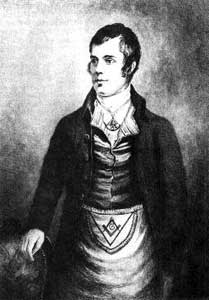 |
|
It is not a pleasing task to dispel such a happy delusion, but it must be admitted that the investiture certainly did not take place on that occasion, when there is no record that Burns was even present. Had the investiture taken place, it would certainly have been recorded on the Minutes, especially when regard is had to the fact that his very admission to the Lodge a month previously was made the subject of so special a note. There were only three meetings of the Lodge held in 1786-7 session, and at one of these only, - that of the night of his admission as a Joining Member - is there any record of the presence of Robert Burns. But did not Burns call himself Laureated, somebody may ask. Certainly he did, particularly in the following stanza:
To please you and praise you,
Ye ken your Laureate scorns;
The prayer still you share still
Of grateful Robert Burns.
But those words were written on May 3, 1786, before the date of his admission into Lodge, Canongate Kilwinning. While Brother Burns may not have actually been appointed Poet Laureate of Canongate Kilwinning Lodge, and the account of the meeting of February 1 does not indicate anything more than that he was "assumed" a member, yet later mention of Brother Burns in the Minutes does suggest that the Brethren in some degrees considered our Brother as Poet Laureate.
For instance, on February 9, 1815, the Lodge resolved to open a subscription among its members to aid in the erection of a "Mausoleum to the memory of Robert Burns who was a member and Poet Laureate of this Lodge". There is the further allusion on January 16, 1835, in connection with the appointment of Brother James Hogg, the "Ettrick Shepherd" to the "honorary office of Poet Laureate of the Lodge, which had been in abeyance since the death of the immortal Brother Robert Burns" (see also Lodge).
Shortly after the publication of the second edition of his verse at Edinburgh, Burns set out on a tour with his friend, Brother Robert Ainslie, an Edinburgh lawyer. Brother A.M. Mackay tells us in a pamphlet issued by Lodge Saint David, Edinburgh, No. 36, on the Festival of Saint John, December 19, 1923, that "Burns visited the old fishing town during the course of a tour through the Border Counties in the early summer of 1787". The records of the Lodge contain no reference to the Poet, or to the Royal Arch Degree of which Burns and his friend became members, but several prominent Brethren in Saint Ebbe were Royal Arch Masons and, although working under no governing authority, appear to have occasionally admitted candidates into that Order. Brothers Burns and Ainslie arrived at Eyemouth on Friday, May 18, and took up their abode in the house of Brother William Grieve, who was, the Poet informs us, "a joyous, warm hearted, jolly, clever fellow". It was, no doubt, at the instigation of their host that the meeting of Royal Arch Masons, held on the following day, was arranged:
- Eyemouth 19th May 1787. At a general encampment held this day, the following Brethren were made Royal Arch Masons, namely:
- Robert Burns, from Lodge Saint James, Tarbolton, Ayrshire;
- and Robert Ainslie from the Lodge of Saint Luke, Edinburgh,
- by James Carmichael, William Grieve, Donald Dow, John Clay, Robert Grieve, etc., etc.
Robert Ainslie paid one guinea admission dues, but, on account of Brother Bum's remarkable poetical genius, the encampment unanimously agreed to admit him gratis and considered themselves honored by having a man of such shining annuities for one of their companions.
It is suggested by Brother A. Arbuthnot Murray, formerly Grand Scribe E. of the Supreme Grand Royal Arch Chapter of Scotland, who is an authority on the old working of the Scottish Royal Arch Chapters, that Burns was probably made a Knight Templar as well, as under the old regime the two ceremonies were always given together (see also Mark).
Dudley Wright in Robert Burns and Freemasonry says, "On December 27, 1788, Burns was unanimously assumed, being a Master Masson a member of the Saint Andrews Lodge, No. 179, Dumiries. The Secretary wrongly described him as of 'Saint David Strabolton Lodge, No. 178'". The poet's last attendance at this Lodge was in 1796, a few months after which he contracted the fatal fever which led to his death.
A word should be said here in refutation of the slanderous charge that Burns acquired the habits of dissipation, to which he was unfortunately addicted, at the festive meetings of the Masonic Lodges (see Freemasons Magazine, London, volume v, page 291), and his brother, Gilbert's, testimony is given below:
"Towards the end of the period under review, in his, twenty-fourth year, and soon after his father's death, he was furnished with the subject of his epistle to John Rankin. During this period, also, he became a Freemason, which was his first introduction to the life of a boon companion. Yet, notwithstanding these circumstances, and the praise he has bestowed on Scotch drink, which seems to have misled his historians, I do not recollect during these seven years, nor till towards the end of his commencing author, when his growing celebrity occasioned his often being in company, to have ever seen him intoxicated; nor was he at all given to drinking".
Notwithstanding this, however, the poet undoubtedly enjoyed convivial gatherings and he wrote to a friend, James Smith:
"I have yet fixed on nothing with respect to the serious business of life. I am, as usual, a rhyming, Mason-making, rattling, aimless, idle fellow".
In spite of this "idleness", Burns was very prolific in verse and especially did he give of his genius liberally in service to the Masonic Order, an example of one of these verses being given below:
A' ye whom social pleasure charms,
Whose heart the tide of kindness warms,
Wha hold your being on the terms,
Each aid the others,
come to my bowl, come to my arms,
My friends, my Brothers.
Among the various poetic Masonic effusions of this "heaven-taught plowman" is the following, which was written in memory of his beloved friend, a fellow-poet and Brother, Robert Ferguson:
Curse on ungrateful man that can be pleased,
And yet can starve the author of his pleasure.
Oh, thou, my Elder Brother in misfortune,
By far my elder Brother in the Muses,
With tears I pity thy unhappy fate!
Why is the bard unfitted for the wond,
Yet has so keen a relish of its pleasures?
Part of the proceeds of the Edinburgh edition of Burns' poems was used in the erection of a tombstone over the remains of this same Scottish poet, Robert Ferguson, on which he inscribed the stanza:
No sculptured marble here, nor pompous lay,
No storied um, nor animated bust,
This simple stone directs pale Scotis's way,
To pour her sorrows o'er her poet's dust.
|
A monument was erected for Robert Burns, himself, by public subscription, at his birthplace, January 25, 1820. The corner-stone was laid with appropriate Masonic honors by the Deputy Grand Master of the Ancient Mother Lodge at Kilwinning, assisted by all the Masonic Lodges in Ayrshire. |
|
At a meeting in 1924 of the Scots Lodge of London in honor of Robert Burns, Sir John A. Cockbum, M.D., in the address of the evening explained to us that the poet when young had suffered from a rheumatic fever that frequently resulted in a condition peculiarly liable at any time later to sudden fatal consequences. Sir John also urged that due consideration should be given to the tendency and practice of the era when Burns flourished, when a free use of intoxicants was common.
Everything that is done in a Masonic Lodge, relating to the initiation of candidates into the several degrees, is called its work or labor; all transactions such as are common, to other associations and societies come under the head of business, and they are governed with some peculiar differences by rules of order, as in other societies (see 0rder, Rules of).
BYBLOSAn ancient city of Phenicia, celebrated for the mystical worship of Adonis, who was slain by a wild boar. It was situated on a river of the same name, whose waters, becoming red at a certain season of the year by the admixture of the clay which is at its source, were said by the celebrants of the mysteries of Adonis to be tinged with the blood of that god. This Phoenician city, so distinguished for the celebration of these mysteries, was the Gebal of the Hebrews, the birthplace of the Giblemites, or stone-squarers, who wrought at the building of King Solomon's Temple; and thus those who have advanced the theory that Freemasonry is the successor of the Ancient Mysteries, think that they find in this identity of Byblos and Gebal another point of connection between these Institutions. |
|
Every subordinate Lodge is permitted to make its own by-laws, provided they do not conflict with the regulations of the Grand Lodge, nor with the ancient usages of the Fraternity. But of this, the Grand Lodge is the only judge, and therefore the original by-laws of every Lodge, as well as all subsequent alterations of them, must be submitted to the Grand Lodge for approval and confirmation before they can become valid, having under the English Constitution previously been approved by the Provincial or District Grand Master.
[- Previos: BRET - BUIL -] [- TOP -] [- Next: INDEX -]